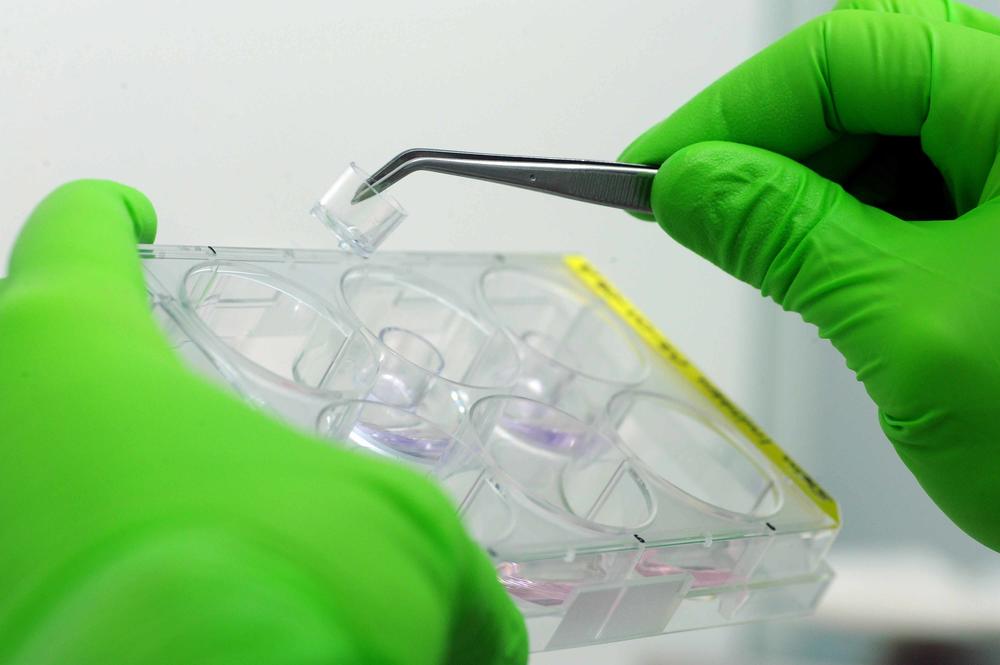Immune Cells in Skin Models
A team led by pharmacology professor Burkhard Kleuser is developing an immune-competent skin model that can be used to identify allergens
Mar 24, 2023
A model of human skin created from hair follicles will soon also contain immune cells.
Image Credit: David Ausserhofer
Today it is possible to find out if new drugs or cosmetics will cause harm to humans without animal testing. This is done using skin models made from human cells. They consist of two different layers: the keratinocytes, which make up 90 percent of the top layer of skin, the epidermis; and the fibroblasts, the underlying elastic connective tissue layer. However, to ascertain whether chemicals and drugs can trigger allergic reactions, such as a nickel allergy, guinea pigs are often used and exposed to high doses of the substance in question. According to Burkhard Kleuser, a professor of pharmacology and toxicology at Freie Universität Berlin, this is necessary because so far it has not been possible to integrate immune cells into the skin models. He and his research team aim to change that.
There are immune cells in the skin, called dendritic cells, which search the layers of the skin for foreign substances that have penetrated the skin. If they discover something, they pick it up with their long tentacles and move on to the next lymph node. There they activate the T-cells, which results in an inflammatory reaction. The T stands for thymus, a part of the immune system in the chest where the cells are differentiated.
Hair Follicles Provide Cells for Skin Models
In the past, researchers obtained cells for skin models from surgical material, from the severed foreskins of boys suffering from phimosis. Today, hair follicles can also be used for this purpose. Kleuser explains, “They contain progenitor cells that we reprogram into pluripotent stem cells in order to grow the desired cells for the model.”
The individual hairs are cultivated in a Petri dish, where keratinocytes and fibroblasts develop. They are sorted and propagated separately. “We reprogram some of the keratinocytes to become stem cells, which then differentiate into the desired immune cells after we add various media and growth factors,” explains doctoral student Marla Dubau. Once recovered, the skin cells and immune cells can be frozen, thawed, and made to divide again many times. Next, the cells are sown step by step like plant seeds. The fibroblasts are placed at the bottom of the culture medium, where they continue to divide, growing together like a lawn. They produce collagen, which makes this layer elastic. The keratinocytes are then placed on top of this layer and form the second layer. They grow upward, and as soon as they protrude from the liquid and come into contact with air, they begin to differentiate and form several fine layers, just like in real human skin. “In the next step the immune cells are integrated,” says Dubau.
The Decisive Step: Integrating Immune Cells into the Skin Model
At least, that is the plan. Kleuser’s team has not yet integrated these immune cells into the model. In the past, attempts were already made to build immune-competent skin models using immune cells from the blood. However, this turned out to be difficult, as Kleuser explains. “That is why we had the idea of cultivating all the components from the same original cell in order to obtain optimal conditions,” he says. He is confident about the plan. The construction of the two-layer model works smoothly, as does the formation of the immune cells. The team intends to take the decisive step soon.
A joint project with Professor Sarah Hedtrich from the Berlin Institute of Health in Charité – Universitätsmedizin Berlin was initially funded by the German Federal Ministry of Education and Research (BMBF). It is currently being funded from the budget of the Animal Welfare Officers of the State of Berlin.
Assuming it works, what happens if the skin model is exposed to foreign substances? “Then the keratinocytes excrete certain alarm substances, so-called cytokines. They alert and attract immune cells. Within twelve to 24 hours, they migrate downward through the layers of skin.” Normally they would be looking for a lymph node but, of course, that does not exist in the skin model. What happens in that case?
Activation of the Immune System Could Be Measured Precisely
“We think that they escape from the model into the culture medium, and we can see that under the microscope,” says Kleuser. The degree of activation of the immune system can be measured precisely, for example, by taking a certain amount of the culture medium and counting the dendritic cells in it.
Using hair follicles as a basis for skin models has a major advantage. All the previous models were mainly based on cells from young male donors. However, hair can be obtained without any invasive procedure from men and women, young and old, healthy and sick, and people with different ethnic backgrounds. “We know that women are more susceptible to nickel allergies than men and that dark skin reacts differently than light skin. But otherwise, surprisingly little is known about the differences,” stresses Kleuser, continuing, “Soon we will have an opportunity to categorize all of these differences using corresponding variants of the skin models.” And that will be possible entirely without animal experiments.
The original German version of this article appeared in the Tagesspiegel newspaper supplement published by Freie Universität Berlin.

